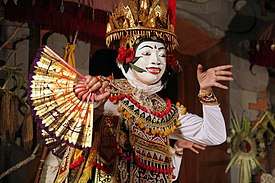Gambyong
Gambyong dance is a form of classical Javanese dance originating from the region of Surakarta, Central Java, Indonesia. This dance is usually performed for shows or to welcome guests. Gambyong not only consists of one dance but many choreographies, the most famous of which are Gambyong Pareanom Dance (with several variations) and Gambyong Pangkur Dance (with several variations). Although there are many kinds, this dance has the same basic movements. Basically, gambyong was created for single dancers, but now it is often done by several dancers by adding elements of blocking the stage so that it involves lines and all stage.[1]
Gambyong Langenkusuma (Pangkur version of Mangkunegaran Palace) dancers, during performance at Prangwedanan, Mangkunegaran Palace, Surakarta. | |
| Native name | Tari Gambyong |
|---|---|
| Origin | Indonesia |
| Gambyong |
|---|
|
| Burma |
| Cambodia |
|
| Indonesia |
|
| Laos |
| Malaysia |
| Philippines |
| Thailand |
| Vietnam |
Serat Centhini, a book written during the reign of Pakubuwana IV (1788-1820) and Pakubuwana V (1820-1823), has referred to the existence of gambyong as a tlèdhèk dance. Furthermore, one of the dancers during the reign of Pakubuwana IX (1861-1893) named K.R.M.T. Wreksadiningrat worked on this folk dance so that it would be appropriate to be performed among nobles or prijajis.
An important change occurred when in 1950, Nyi Bei Mintoraras, a dance trainer from Mangkunegaran Palace during Mangkunegara VIII, made a "standardized" gambyong version, known as Gambyong Pareanom. This choreography was first performed at the wedding ceremony of Gusti Nurul, MN VIII's sister, in 1951. The dance was favored by the community so that other versions developed for the consumption of the wider.[2][3]
See also
References
- "Tari Gambyong". indonesiakaya.com (in Indonesian). Retrieved 2020-07-07.
- "Tari Gambyong Pareanom". surakarta.go.id (in Indonesian). Retrieved 2020-07-07.
- "Pecahkan Rekor Muri 5000 Penari Gambyong Akan Goyang Kota Solo". kompas.com (in Indonesian). Retrieved 2020-07-07.
.svg.png)
